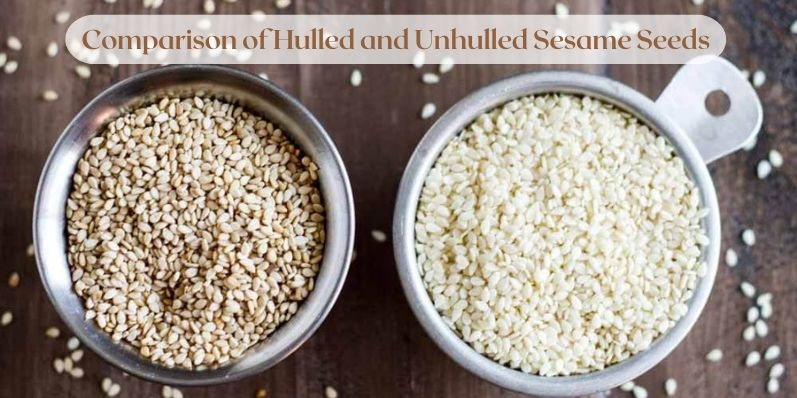
07-09-2023
A Comparison of Hulled and Unhulled Sesame Seeds
- Admin
Sesame seeds have been a staple in culinary traditions around the world for centuries, adding a delightful nutty flavor and a satisfying crunch to a wide range of dishes. These tiny seeds are not only a popular ingredient but also offer various health benefits. One key consideration when using sesame seeds in your cooking is whether to opt for hulled or unhulled sesame seeds. Each variety has its unique characteristics and uses, making it important to understand the differences between them.
What Are Hulled Sesame Seeds?
Hulled sesame seeds, also known as white sesame seeds, are the inner, edible part of the sesame seed after removing the outer husk or shell. This process involves cleaning, hulling, and sometimes toasting the seeds to achieve the desired flavor and appearance. Hulled sesame seeds are commonly available in most grocery stores and are widely used in various culinary applications.
What Are Unhulled Sesame Seeds?
Unhulled sesame seeds, on the other hand, are the whole sesame seeds, including the outer husk or shell. Unlike hulled sesame seeds, they are not processed to remove this outer layer. Unhulled sesame seeds are also referred to as "natural" or "brown" sesame seeds due to their darker appearance compared to the hulled variety.
Now, let's delve into a detailed comparison of hulled and unhulled sesame seeds across various aspects:
1. Flavor:
Hulled Sesame Seeds: Hulled sesame seeds have a milder, nuttier flavor compared to their unhulled counterparts. This makes them ideal for recipes where you want the sesame flavor to be less pronounced.
Unhulled Sesame Seeds: Unhulled sesame seeds have a stronger, more robust flavor with a slightly bitter note due to the presence of the husk. This makes them a better choice when you want a more intense sesame taste.
2. Appearance:
Hulled Sesame Seeds: These seeds are small, ivory-colored, and uniform in appearance. They are often used as a garnish in both sweet and savory dishes due to their appealing look.
Unhulled Sesame Seeds: Unhulled sesame seeds are darker in color, with a mix of tan and brown hues. Their uneven texture and speckled appearance can add an interesting visual element to your dishes.
3. Nutritional Value:
Hulled Sesame Seeds: Hulled sesame seeds are slightly lower in fiber and certain nutrients compared to unhulled seeds. However, they are still a good source of essential minerals like calcium, magnesium, and iron, as well as healthy fats.
Unhulled Sesame Seeds: Unhulled sesame seeds retain their outer layer, making them richer in fiber and certain antioxidants. They also contain more calcium and other minerals due to the presence of the husk.
4. Culinary Uses:
Hulled Sesame Seeds: Hulled sesame seeds are versatile and commonly used in baking, salad dressings, and as a topping for bread, buns, and bagels. They are a great choice for dishes where you want the sesame flavor without the added bitterness.
Unhulled Sesame Seeds: Unhulled sesame seeds are less common in Western cuisine but are widely used in Asian and Middle Eastern dishes. They are often incorporated into tahini, a sesame paste, and are used to garnish sushi rolls, stir-fries, and roasted vegetables.
5. Health Benefits:
Hulled Sesame Seeds: Hulled sesame seeds offer a range of health benefits, including providing a good source of protein, healthy fats, and essential nutrients. They can support bone health, heart health, and overall well-being.
Unhulled Sesame Seeds: Unhulled sesame seeds have a higher fiber content, which can aid in digestion and promote a feeling of fullness. They also contain more antioxidants due to the presence of the husk.
6. Shelf Life:
Hulled Sesame Seeds: Due to the removal of the husk, hulled sesame seeds have a longer shelf life and are less prone to spoilage compared to unhulled seeds.
Unhulled Sesame Seeds: Unhulled sesame seeds, with their husks intact, are more susceptible to spoilage and may have a shorter shelf life. Proper storage in a cool, dry place is essential to maintain their freshness.
In conclusion, the choice between hulled and unhulled sesame seeds depends on your culinary preferences and the specific requirements of your recipes. Hulled sesame seeds offer a milder flavor and are more commonly used in Western cuisine, while unhulled sesame seeds provide a bolder flavor and are popular in Asian and Middle Eastern cooking. Both varieties offer nutritional benefits, so you can choose the one that best suits your taste and dietary needs. Experimenting with both types of sesame seeds can also add variety and depth to your culinary creations, allowing you to explore the diverse world of flavors that sesame seeds have to offer.